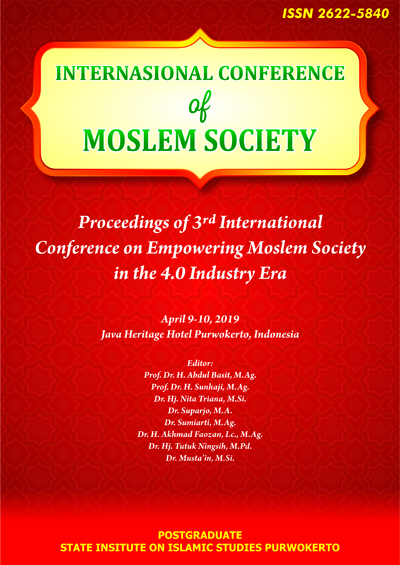Smart Teachers in Building Students’ Character in 4.0 Industrial Revolution Era
DOI:
https://doi.org/10.24090/icms.2019.2385Keywords:
smart teacher, character building, 4.0 industrial revolution eraAbstract
A teacher is one element that is very vital in running education, which is one of the most important aspects in the 4.0 industrial revolution era. For that reason, the quality of a teacher will be a very contributing factor to the success of education in. In such an era, smart teachers should be equipped with innovations and creativity and are able to make a fun and interactive teaching and learning process. They are also expected to be able to encourage students to be active to participate in the learning process in order to make sure that the objectives of learning can be achieved. In this era, teachers’ role in developing students’ character is significant. This is because students will face this millennial era, which come a long with all chances and threat, and they should equip themselves with good characters as well as specific skills needed. The broad use of the internet will of course give some impacts to students’ characters, either the good and the bad ones. For that reason, character building at schools is really needed to avoid students from losing their identity. Building students’ character needs smart teachers who have four competencies, i.e. professional, paedagogic, personal, and social competencies. Having such competencies, teachers are expected to be able to build students’ good character and can help students to have the characters which go along with parents’ and community’s expectations. The efforts to build students’s characters can be realized through intra and extra-curriculair activities to facilitate students in developing the 18 characters as stated by Education and Culture Ministry of Indonesia.Downloads
Download data is not yet available.
References
Farida, A. (2014).Sekolah Menyenangkan. Bandung: Nuansa Cendikia.
https://www.hitsss.com/kenali-lebih-jauh-karakteristik-generasi-millennial-lewat-7-poin-ini/3/diakses tanggal 27 Februari 2019.
https://rumahmillennials.com/siapa-itu-generasi-millenials/diakses tanggal 27 Februari 2019.
Kemendiknas. (2010). Desain Induk Pendidikan Karakter. Jakarta: t.t.
Kurniawan, H. (2016). Sekolah Kreatif. Yogyakarta: AR-RUS MEDIA.
Lalo, K. (2019). “Menciptakan Generasi Milenial Berkarakter dengan Pendidikan Karakter Guna Menyongsong Era Globalisasiâ€, Online Jurnal of Jurnal Ilmu Kepolisian,12, No. 2 (Juli 2018), 72(diakses tanggal 26 Februari 2019).
Miller, J.P. (2002). Cerdas diKelas Sekolah Kepribadian.Yogyakarta: Kreasi Wacana Yogjakarta.
Musfah, J. (2011). Peningkatan Kompetensi Guru. Jakarta: Prenada Media grup.
Ningsih, T. (2014). Implemetasi Pendidikan Karakter. Purwokerto: STAIN Press.
Ningsih, T. (2015). “Implemetasi Pendidikan Karakter di SMPN 9 dan SMPN 8 Purwokertoâ€Desertasi. Yogyakarta:UNY.
Revolusi Industri 4.0: Pengertian, Prinsip, dan Tantangan Generasi Milenial viranda tresya https://www.maxmanroe.com/revolusi-industri-4-0.htmdiakses tanggal 27 Februari 2019.
Roqib, M. & Nurfuadi. (2011). Kepribadian Guru. Purwokerto: STAIN Press.
Suwito & Nurfuadi. (2012). Professionalism Guru. Purwokerto: Stain Press.
Tilaar (2002). Pendidikan untuk Indonesia Baru70 tahun. Jakarta: PT Grasindo.
Uno, H.B. (2016). Profesi Kependidikan. Jakarta: Bumi Aksara.
Wikipedia bahasa Indonesia, ensiklopedia bebasdiakses tanggal 27 Februari 2019.
https://www.hitsss.com/kenali-lebih-jauh-karakteristik-generasi-millennial-lewat-7-poin-ini/3/diakses tanggal 27 Februari 2019.
https://rumahmillennials.com/siapa-itu-generasi-millenials/diakses tanggal 27 Februari 2019.
Kemendiknas. (2010). Desain Induk Pendidikan Karakter. Jakarta: t.t.
Kurniawan, H. (2016). Sekolah Kreatif. Yogyakarta: AR-RUS MEDIA.
Lalo, K. (2019). “Menciptakan Generasi Milenial Berkarakter dengan Pendidikan Karakter Guna Menyongsong Era Globalisasiâ€, Online Jurnal of Jurnal Ilmu Kepolisian,12, No. 2 (Juli 2018), 72(diakses tanggal 26 Februari 2019).
Miller, J.P. (2002). Cerdas diKelas Sekolah Kepribadian.Yogyakarta: Kreasi Wacana Yogjakarta.
Musfah, J. (2011). Peningkatan Kompetensi Guru. Jakarta: Prenada Media grup.
Ningsih, T. (2014). Implemetasi Pendidikan Karakter. Purwokerto: STAIN Press.
Ningsih, T. (2015). “Implemetasi Pendidikan Karakter di SMPN 9 dan SMPN 8 Purwokertoâ€Desertasi. Yogyakarta:UNY.
Revolusi Industri 4.0: Pengertian, Prinsip, dan Tantangan Generasi Milenial viranda tresya https://www.maxmanroe.com/revolusi-industri-4-0.htmdiakses tanggal 27 Februari 2019.
Roqib, M. & Nurfuadi. (2011). Kepribadian Guru. Purwokerto: STAIN Press.
Suwito & Nurfuadi. (2012). Professionalism Guru. Purwokerto: Stain Press.
Tilaar (2002). Pendidikan untuk Indonesia Baru70 tahun. Jakarta: PT Grasindo.
Uno, H.B. (2016). Profesi Kependidikan. Jakarta: Bumi Aksara.
Wikipedia bahasa Indonesia, ensiklopedia bebasdiakses tanggal 27 Februari 2019.
Downloads
Published
2019-04-12
How to Cite
Ningsih, T. (2019). Smart Teachers in Building Students’ Character in 4.0 Industrial Revolution Era. International Conference of Moslem Society, 3, 58–68. https://doi.org/10.24090/icms.2019.2385
Issue
Section
ICMS 2019
License
Authors who publish with this journal agree to the following terms:
- Authors retain copyright and grant the journal right of first publication with the work simultaneously licensed under a Creative Commons Attribution-ShareAlike 4.0 License that allows others to share the work with an acknowledgement of the work's authorship and initial publication in this journal.
- Authors are able to enter into separate, additional contractual arrangements for the non-exclusive distribution of the journal's published version of the work (e.g., post it to an institutional repository or publish it in a book), with an acknowledgement of its initial publication in this journal.
- Authors are permitted and encouraged to post their work online (e.g., in institutional repositories or on their website) prior to and during the submission process, as it can lead to productive exchanges, as well as earlier and greater citation of published work (See The Effect of Open Access).


